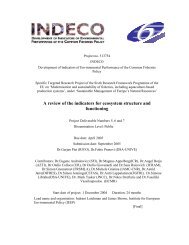WP5 Case study on genetic resources in food and agriculture
WP5 Case study on genetic resources in food and agriculture
WP5 Case study on genetic resources in food and agriculture
Create successful ePaper yourself
Turn your PDF publications into a flip-book with our unique Google optimized e-Paper software.
5.3 C<strong>on</strong>servati<strong>on</strong> of plant <strong>genetic</strong> <strong>resources</strong>Pol<strong>and</strong> is a unique example for Eastern Europe, where several traditi<strong>on</strong>al l<strong>and</strong>races ofcrops survived ow<strong>in</strong>g to the ‘crumbled’ structure of farm<strong>in</strong>g. The most important area,where old varieties are cultivated, is the southern part of the country <strong>and</strong> <strong>in</strong>cludes themounta<strong>in</strong> regi<strong>on</strong>s of Beskidy, the Tatra <strong>and</strong> their forel<strong>and</strong>s. M<strong>in</strong>or refugial regi<strong>on</strong>s havebeen discovered <strong>in</strong> eastern <strong>and</strong> south-eastern Pol<strong>and</strong> <strong>in</strong> Polesie, Wyzyna Lubelska <strong>and</strong> <strong>in</strong>the bas<strong>in</strong> of S<strong>and</strong>omierz. Because of climatic, ecogeographic, <strong>and</strong> edafic c<strong>on</strong>diti<strong>on</strong>s, <strong>in</strong>which local cultivars could compete with new varieties, <strong>and</strong> fairly primitive agriculturalpractices, those areas served as refuge for several local varieties. Well adapted to thespecific envir<strong>on</strong>mental c<strong>on</strong>diti<strong>on</strong>s, they guaranteed not high, but stable yields also <strong>in</strong>unfavourable years. Still, with structural <strong>and</strong> cultural changes <strong>in</strong> rural areas <strong>and</strong>ab<strong>and</strong><strong>on</strong>ment of traditi<strong>on</strong>al farm<strong>in</strong>g methods, many of these old varieties are <strong>in</strong> danger ofext<strong>in</strong>cti<strong>on</strong>. With many of these crops ma<strong>in</strong>ly be<strong>in</strong>g cultivated <strong>on</strong> small farms by oldpeople who are str<strong>on</strong>gly attached to traditi<strong>on</strong> <strong>and</strong> who still harbour knowledge aboutmethods of home multiplicati<strong>on</strong> of crops, this knowledge is at risk.Ma<strong>in</strong> measures for the c<strong>on</strong>servati<strong>on</strong> of plant <strong>genetic</strong> <strong>resources</strong> <strong>in</strong> <strong>agriculture</strong> directlyfunded by the state are:• support of botanical gardens, arboretums, gene banks <strong>and</strong> other <strong>in</strong>stituti<strong>on</strong>s, <strong>and</strong>• fund<strong>in</strong>g of almost yearly expediti<strong>on</strong>s to search for <strong>and</strong> collect old cultivars <strong>and</strong>local l<strong>and</strong>races.Collect<strong>in</strong>g <strong>and</strong> both, ex situ <strong>and</strong> <strong>in</strong> situ c<strong>on</strong>servati<strong>on</strong> of plant <strong>genetic</strong> <strong>resources</strong> have al<strong>on</strong>g traditi<strong>on</strong> <strong>in</strong> Pol<strong>and</strong>, beg<strong>in</strong>n<strong>in</strong>g with activities of the Research Institute of Agr<strong>on</strong>omyat Pulawy <strong>in</strong> 1922. The Plant Breed<strong>in</strong>g <strong>and</strong> Aclimatizati<strong>on</strong> Institute (IPBA),established <strong>in</strong> 1951, collected crops with particular c<strong>on</strong>siderati<strong>on</strong> of the Polish localcultivars <strong>and</strong> ecotypes. In 1979 the Nati<strong>on</strong>al Crop Genetic Resources C<strong>on</strong>servati<strong>on</strong>Programme was set up, aim<strong>in</strong>g at preserv<strong>in</strong>g <strong>genetic</strong> material of major crops <strong>and</strong> theirwild relatives for breed<strong>in</strong>g <strong>and</strong> research through collecti<strong>on</strong>, evaluati<strong>on</strong>, preservati<strong>on</strong> <strong>and</strong>documentati<strong>on</strong> of genotypes endangered with ext<strong>in</strong>cti<strong>on</strong>. It is f<strong>in</strong>anced by the MoA <strong>and</strong>based <strong>on</strong> multi-<strong>in</strong>stituti<strong>on</strong>al <strong>in</strong>put. Three universities, 9 <strong>in</strong>stitutes, 7 experimental stati<strong>on</strong>s,<strong>and</strong> the Botanical Garden of the Polish Academy of Science carry the resp<strong>on</strong>sibilities forcrop collecti<strong>on</strong>s.Systematic collecti<strong>on</strong> <strong>and</strong> c<strong>on</strong>servati<strong>on</strong> of <strong>in</strong>digenous plant <strong>genetic</strong> <strong>resources</strong> <strong>in</strong> Pol<strong>and</strong>started <strong>in</strong> 1971 with expediti<strong>on</strong>s be<strong>in</strong>g carried out almost annually with the follow<strong>in</strong>gpurposes:• Collecti<strong>on</strong> of old cultivars <strong>and</strong> local l<strong>and</strong>races of agricultural <strong>and</strong> horticulturalcrops <strong>and</strong> their weedy <strong>and</strong> wild counterparts,• collecti<strong>on</strong> of ecotypes of grasses,• collecti<strong>on</strong> of plant material for research - special purpose collecti<strong>on</strong>,• m<strong>on</strong>itor<strong>in</strong>g the progress of <strong>genetic</strong> erosi<strong>on</strong>.33




